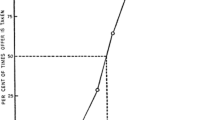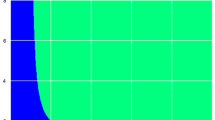Abstract
We introduce a novel method of modellingcontests that avoids the complexitiesencountered by the `best response function'approach. We analyse contests in which (i)there are many risk averse players, (ii)attitudes to risk may differ acrossindividuals, and (iii) the technology thattransforms rent-seeking effort intoprobability of winning may also differacross individuals. We establish that, ifevery player has a constant degree ofabsolute risk aversion, a uniqueequilibrium exists. We also establishcomparative static results and examine howthe level of rent dissipation is affectedby the heterogeneity of attitudes towardsrisk and the precise nature of the technology.
Similar content being viewed by others
References
Arrow, K.J. (1970). Essays in the theory of risk-bearing. Amsterdam: North Holland.
Clark, D.J. and Riis, C. (1997). Contest success functions: An extension. Economic Theory 11: 201-204.
Cornes, R.C. and Hartley, R. (2000). Joint production games and share functions. Unpublished manuscript.
Dixit, A.K. (1987). Strategic behavior in contests. American Economic Review 77: 891-898.
Frank, R.H. (1985). Choosing the right pond: Human behavior and the quest for status. Oxford: Oxford University Press.
Frank, R.H. and Cook, P.J. (1995). The winner-take-all society. Harmondsworth: Penguin.
Fudenberg, D. and Tirole, J. (1986). A theory of exit in duopoly. Econometrica 54: 943-960.
Garfinkel, M.R. and Skaperdas, S. (1996). The political economy of conflict and appropriation. Cambridge: Cambridge University Press.
Ghemawat, P. and Nalebuff, B. (1985). Exit. RAND Journal of Economics 16: 184-194.
Hillman, A.L. (1989). The political economy of protection. Chur: Harwood Academic Publishers.
Hillman, A.L. and Katz, E. (1984). Risk-averse rent seekers and the social cost of monopoly power. Economic Journal 94: 104-110.
Hillman A.L. and Riley, J.G. (1989). Politically contestable rents and transfers. Economics and Politics 1: 17-39.
Huck, S., Konrad, K.A. and Mueller, W. (2001). Merger and collusion in contests. Discussion Paper FS IV 01-04, Wissenschaftszentrum Berlin.
Konrad, K.A. and Schlesinger, H. (1997). Risk aversion in rent-seeking and rent-augmenting games. Economic Journal 107: 1671-1683.
Loury, G. (1979). Market structure and innovation. Quarterly Journal of Economics 93: 395-410.
Nalebuff, B.J. and Stiglitz, J.E. (1982). Prizes and incentives: Towards a general theory of compensation and competition. Bell Journal of Economics 13: 21-43.
Nitzan, S. (1994). Modelling rent-seeking contests. European Journal of Political Economy 10: 41-60.
Riley, J.G. (2000). Asymmetric contests: A resolution of the Tullock paradox. In Howitt, P., De Antoni, E. and Leijonhufvud, A. (Eds.), Money, markets and method: Essays in honor of Robert W. Clower. Cheltenham: Edward Elgar.
Skaperdas, S. (1996). Contest success functions. Economic Theory 7: 283-290.
Skaperdas, S. and Gan, L. (1995). Risk aversion in contests. Economic Journal 105: 951-962.
Szidarovszky, F. and Okuguchi, K. (1997). On the existence and uniqueness of pure Nash equilibrium in rent-seeking games. Games and Economic Behavior 18: 135-140.
Tullock, G. (1980). Efficient rent seeking. In Buchanan, J.M., Tollison, R.D. and Tullock, G. (Eds.), Toward a theory of the rent-seeking society, 97-112. College Station: Texas A & M University Press.
Whinston, M.D. (1988). Exit with multiplant firms. RAND Journal of Economics 19: 568-588.
Author information
Authors and Affiliations
Rights and permissions
About this article
Cite this article
Cornes, R., Hartley, R. Risk Aversion, Heterogeneity and Contests. Public Choice 117, 1–25 (2003). https://doi.org/10.1023/A:1026136008608
Issue Date:
DOI: https://doi.org/10.1023/A:1026136008608




